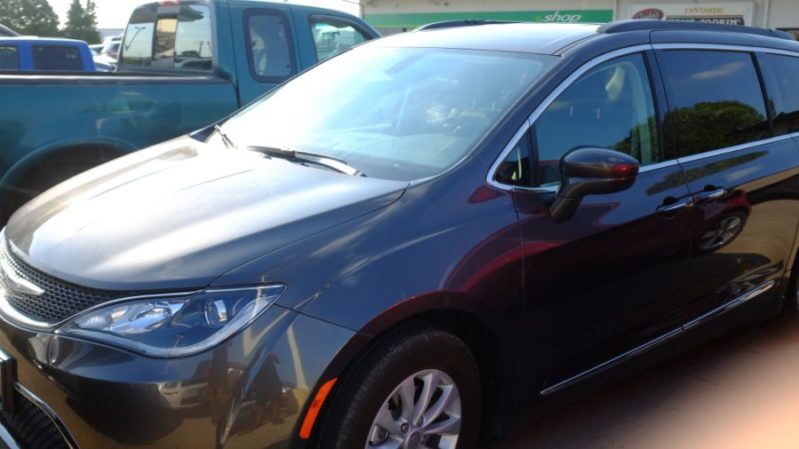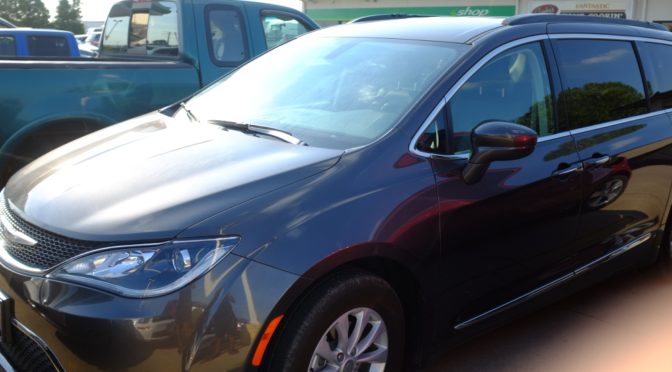The Chrysler Pacifica is easily the most impressive minivan to come from an American manufacturer in US minivan history. Sleek, stylish, swooping, and futuristic, it’s turning a lot of heads and potentially a lot of pocketbooks from more established competitors like the Toyota Sienna, Honda Odyssey, Kia Sedona, Nissan Quest, or domestic stablemates Chrysler Town & Country and Dodge Grand Caravan. It’s eye-catching and, in my opinion, the best American minivan ever produced (and shouldn’t be confused with its prior namesake, the Pacifica SUV of the 2000s). Stocked with many of the latest safety features, it’s also likely to be a strong competitor among families interested in keeping the most precious of cargo as safe as possible.
As a result, I packed my bags and headed to the nearest Chrysler dealer to check out the Pacifica. Yes, it drives nicely, but what I was really interested in was in figuring out just how good of a job it did at the all-important task of fitting 3 car seats across the 2nd and 3rd rows. However, before looking at what I was able to stuff into those rows, let’s look at some good ideas for when to use which kinds of seats in the Pacifica or in any other vehicle.
The safest configuration we know of when it comes to vehicle safety is rear-facing. This goes for adults as well, but it’s uncommon to find rear-facing seats for adults outside of trains. That said, I typically suggest keeping children rear-facing as long as possible (until 4 or 5 like the Swedes), followed by harnessing until they can safely use booster seats (until at least 5, like the Swedes), and then boostering until the 5 step test is passed (typically between 10, 11, and 12). Beyond that, I suggest keeping kids in the back seat until at least 13, and delaying teen solo driving until 18 if possible. We want our little ones in the safest positions we know of for as long as possible to give them the greatest advantages in a collision.
Keeping these ideas in mind, I set to work to find which infant, convertible, combination, and booster seats would work best in 3 across combinations in the Chrysler Pacifica. It’s my goal to make this list the most thorough on the Internet. If you find the list helpful when shopping for car seats, you can shop through my Amazon link below. I’ll add more seats as I test them over time.
You can access the complete 3 across guide for every vehicle here and the complete list of recommended seats here. The Canadian car seat guide is here. 3 across car seat images are courtesy of yours truly.
 2017, 2018, 2019, 2020 Chrysler Pacifica (RU)
2017, 2018, 2019, 2020 Chrysler Pacifica (RU)
Guaranteed 3 across installations:
Clek Fllo (x3).
Clek Foonf (x3).
Clek Oobr (x3).
Peg Perego Flex 120 (x3).
Maxi-Cosi RodiFix (x3).
Diono Radian 3RXT (x3).
Diono Radian 3RX (x3).
Diono Radian RXT (x3).
Diono Radian R120 (x3).
Diono Radian R100 (x3).
Chicco KeyFit 30 (x3).
Graco Size4Me 65 (x3).
Graco Head Wise 65 (x3).
Graco Fit4Me 65 (x3).
Graco Contender (x3).
Combi Coccoro (x3).
Chicco KeyFit 30, Diono Radian / RXT, Chicco KeyFit 30.
Tips and Tricks:
The current generation of the Chrysler Pacifica is 203 inches long and just under 80 inches wide, which is comparable to the length and width of every other minivan currently available in the US market. However, I didn’t find the back row quite as friendly as that in, say, the Odyssey or in the Sienna. That said, you can still fit just about any seats you’re interested in fitting back there without too much trouble. My biggest suggestion is to use the seat belts, as the LATCH anchors aren’t spaced nearly as wide as I’d like them to be (although that tends to be the case in just about every vehicle I look into).
Something to keep in mind is that if you do choose to use LATCH, you’re going to have a beast of a time in the 3rd row, as there’s only one pair of usable lower anchors (those on the passenger side), as the other anchors aren’t actually aligned with their seats. Additionally, while there are a pair of tethers for forward facing (because forward-facing tethering is important), you can only use the center tether for the center or driver’s side seat, and not for both at the same time. The passenger side tether is fully independent. What this means is that you can only safely install two forward-facing seats in the 3rd row.
 If you find my information on best practices in car and car seat safety helpful, you can do your shopping through this Amazon link. Canadians can shop here for Canadian purchases. Have a question or want to discuss best practices? Send me an email at carcrashdetective [at] gmail [dot] com.
If you find my information on best practices in car and car seat safety helpful, you can do your shopping through this Amazon link. Canadians can shop here for Canadian purchases. Have a question or want to discuss best practices? Send me an email at carcrashdetective [at] gmail [dot] com.

